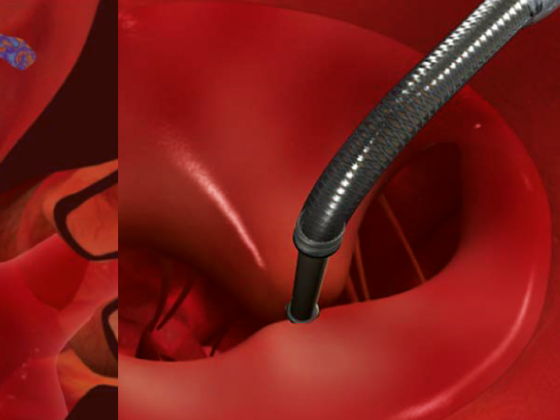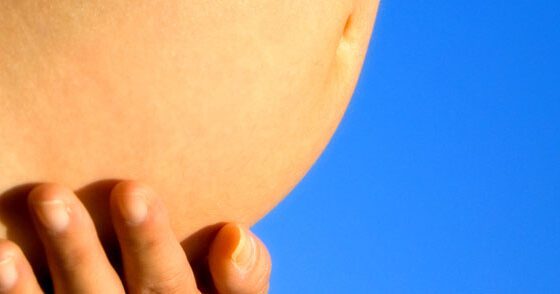As the “little brother of pain”, itching was not usually taken very seriously until recently. Today we know that this trivializing name for this agonizing symptom is by no means accurate – especially since pruritus is mediated via completely different nerve fibers. Dermatologic, systemic non-dermatologic, neurologic, and psychiatric disorders must be considered in the workup.
Itching is mediated by completely different nerve fibers than pain. It originates via cutaneous C-fibers, marrowless fibers found in the epidermis and junctional zone. The receptors on the free nerve endings are excited either mechanically or by light tactile stimuli, such as fibers from a wool sweater, according to Prof. Dr. med. Dr. phil. Johannes Ring of the Christine Kühne Center for Allergy Research and Education, Davos and Munich. Multiple mediators from inflammatory cells, keratinocytes, and mast cells can also excite nerve endings. The itching in urticaria is mainly caused by histamine from mast cells. The messenger of the eczematous itch is still unknown, possibly it is the interleukin 31 produced by T cells. A specific therapy exists almost only against the histamine. Otherwise, as far as the complex network of mediators is concerned, there is still a great need for research.
Itching is a multidimensional sensation that is processed and modulated in the brain. The scratch threshold varies greatly between individuals, but is very constant intraindividually.
Not only skin diseases itch
In principle, the spectrum of causes of pruritus can be divided into dermatological, systemic non-dermatological, neurological and psychiatric/psychosomatic diseases, combinations thereof and diseases of unclear etiology, explained Dr. med. Matthias Möhrenschlager, High Mountain Clinic Davos
Pruritus is inextricably linked to atopic eczema. Of patients with psoriasis vulgaris, over 80% suffer from itching. Systemic non-dermatologic diseases that induce pruritus include chronic renal failure, liver and thyroid diseases, lymphoma, and carcinoids. Patients with primary biliary cirrhosis suffer from pruritus particularly frequently; more than 50% are affected. Less commonly, the symptom occurs in renal disease or Hodgkin’s disease.
Not to be forgotten as a cause of itching are medications. Numerous potentially pruritogenic substances can be identified in the “who’s who” of drugs. These include various antibiotics, antidepressants, antihypertensives, anticonvulsants, beta-blockers and many others. “It includes everything that is prescribed every day in the practice, and everything can induce pruritus,” Dr. Möhrenschlager said.
In the neurological field, multiple sclerosis, cerebral infarcts, abscesses, postherpetic neuralgia, or polyneuropathies can cause itching. Phantom itch can also become a serious problem. Difficult to treat is dermatozoa mania, in which patients literally scratch themselves bloody for fear of being infested with bugs.
With anamnesis and laboratory in the right direction
There are a number of anamnestic questions that can be helpful in determining the cause:
- Do you have atopy or hay fever, asthma, other allergies, or are there any intolerances?
- Has the patient suffered from a systemic disease in the past?
- What medications does he take, what does he do for a living, what hobbies does he pursue, what trips has he taken?
- Does the patient smoke or drink? Are there any mental illnesses, muscle weakness?
- Does the patient suffer from night sweats, flushing symptoms or diarrhea?
- Has he lost weight?
- Which laboratory tests are useful?
Depending on the medical history, ESR, differential blood count, serum levels of calcium and phosphate, creatinine, liver enzymes, alkaline phosphatase, protein, glucose, TSH, in men over 60 years PSA, parameters of iron metabolism, folic acid, zinc, vitamin B12, as well as hepatitis serology may help to discover the cause. Urine status, a stool test for occult blood, and, in the case of anal pruritus, a search for worm eggs and parasites may also be helpful. A skin biopsy may also need to be performed.
If the picture remains unclear, further investigations should be performed such as protein electrophoresis, determination of antinuclear antibodies and porphyrins, HIV test, bacteriological and mycological smears. Careful allergological diagnostics, possibly with provocation testing, should also be performed.
Step therapy of itching
In the treatment of itching, the psyche plays a huge role. This is also indicated by the strong placebo effect, which in studies of atopic eczema is in the order of 50-70%.
Many patients have already been helped with various general measures. “At least you can’t go wrong with it,” says Dr. Möhrenschlager. For example, the patient should avoid as far as possible everything that dries out the skin such as dry climates, sauna visits, alcoholic compresses, ice cube packs, frequent washing and bathing. In addition, he should avoid contact with irritating substances or substances; for example, the popular tea tree oil can cause contact allergies to a large extent.
The pruritus patient should avoid excitement and stress as far as possible; he should also avoid hot and strongly spiced food or large quantities of hot drinks or alcohol.
Tips for personal hygiene
Mild, non-alkaline and moisturizing soaps without preservatives or fragrances are suitable for body hygiene. The water should be lukewarm when showering or bathing (maximum 20 minutes), the skin should then be creamed depending on the skin condition.
If there is manifest dermatosis, the patient should not rub too hard with the terry towel to minimize trauma. Clothing should be soft and airy and preferably made of cotton; wool or synthetic materials must be discouraged.
Creams and lotions containing urea, camphor, menthol or polidocanol are suitable for short-term relief of nocturnal pruritus. Many patients find moist or cooling compresses, cool showers or black tea poultices pleasant. Training aimed at breaking the itch-scratch cycle is useful. It is often helpful to learn relaxation exercises (autogenic training), which can be used in everyday life at any time. Dr. Möhrenschlager: “In any case, the mere admonition not to scratch is pointless.”
Selecting topicals according to indication
When prescribing Topica for itching, it is important to choose the right vehicle. For example, solutions should be used in hairy areas and otherwise creams that are easily absorbed should be used. Ointments provide a good protective function because they remain on the skin longer.
Active ingredients include polidocanol (e.g. Optiderm® cream) and, in the case of inflammatory changes in the skin, glucocorticoids (e.g. prednicarbate, Prednicutan®, Prednitop®). While glucocorticoids can cause skin atrophy in the long term, this is not the case with calcineurin inhibitors, which are also anti-inflammatory, such as tacrolimus (Protopic® ointment) or pimecrolimus (Elidel® cream). Capsaicin (Qutenza®) has proven effective for itching that occurs only at a specific site. Cannabinoid agonists (e.g. Physiogel® cream) have an antipruritic effect by mildly inhibiting inflammation.
The primary focus of therapy for pruritus is to eliminate or treat the cause, such as a contact allergen, a pruritogenic drug, or an underlying systemic disease. As initial symptomatic therapy for patients with urticaria or atopic eczema who suffer from itching during the day, Dr. Möhrenschlager recommends a nonsedating antihistamine such as fexofenadine (Telfast® 180 Film-coated tablet 1-0-0). In the case of predominantly nocturnal itching, affected persons should take a sedating antihistamine such as dimetindene maleate (Fenistil® Dragee 0-0-1/0-0-2) before going to bed and the combination of both antihistamines in the case of pruritus around the clock. Systemic steroids are particularly essential in severe forms of urticaria, drug exanthema, exacerbated atopic eczema, severe allergic contact dermatitis, dyshidrosiform hand and foot eczema, or autoimmune dermatoses and other conditions. According to Dr. Möhrenschlager, the initial dosage should be 0.5-2 mg prednisolone/kg body weight per day. The opioid receptor antagonist naltrexone (Naltrexin® film-coated tablet) is very effective in desiccation eczema, prurigo nodularis, lichen ruber, bullous pemphigoid, cholestatic pruritus, and possibly renal pruritus. The substance has the advantage that it can be given by os. The initial dose of 25 mg/d should be increased by 25 mg every third day up to a maximum of 100 mg/d. The patient should know that initial nausea, vomiting, dizziness and fatigue may occur.
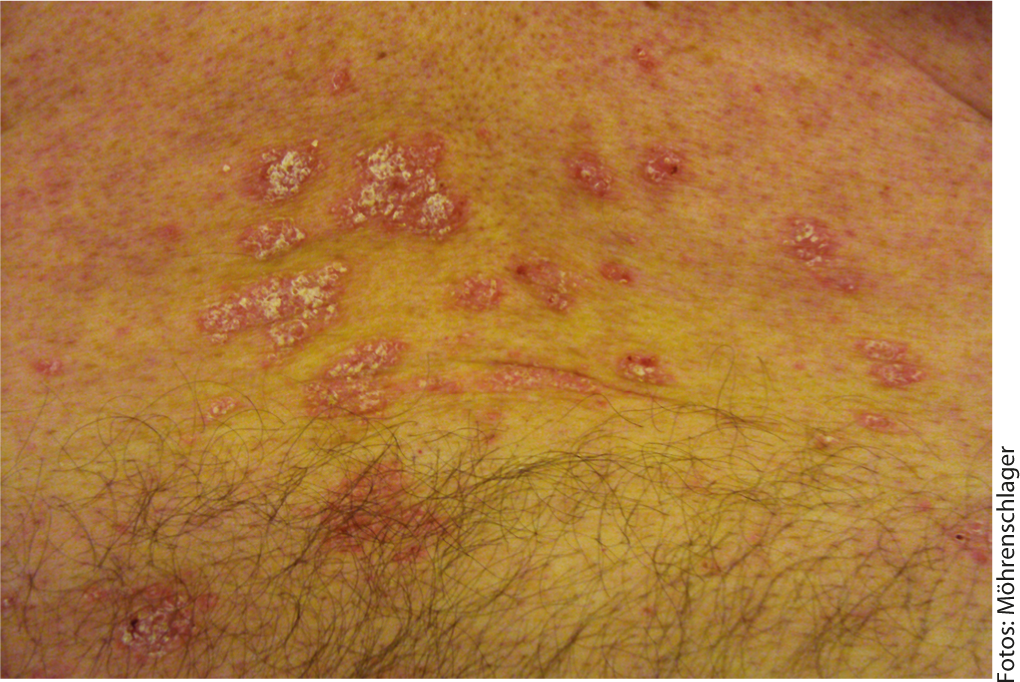
Dermatological causes of pruritus: psoriasis vulgaris
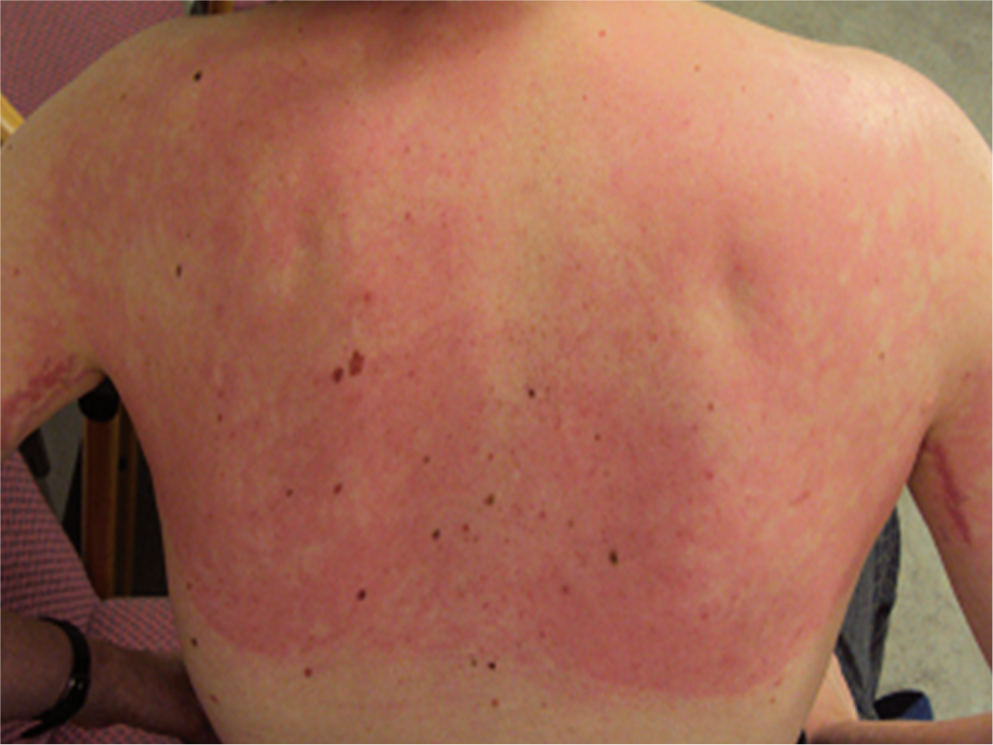
Tinea corporis …

and contact dermatitis
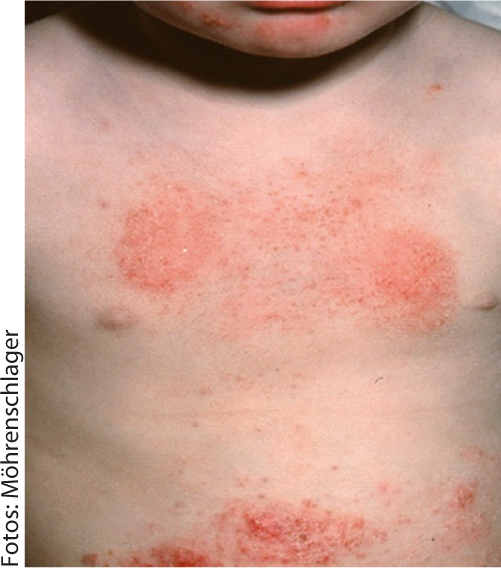
Nummular eczema

Flexural eczema in atopic eczema
Heliotherapy on the sun terrace
Climatic therapy has proven to be a simple therapy option with few side effects, especially in the high mountains, for a wide range of diseases such as atopic eczema, psoriasis vulgaris, prurigo nodularis, cutaneous T-cell lymphoma, generalized pruritus, uremic pruritus, HIV infection, Hodgkin’s disease and other diseases. The high mountain clinic in Davos offers natural heliotherapy with wavelength maxima in the UV-A and UV-B range. “This allows us to simply send patients to the terrace,” Dr. Möhrenschlager said. In the case of urticaria, and possibly also neurodermatitis, the leukotriene antagonist montelukast (Singulair® film-coated tablet) in combination with an antihistamine has proven to be a well effective alternative therapy. The anticonvulsant gabapentin (Neurontin® hard capsule) has also been shown to be highly effective against pruritus of various etiologies at daily doses between 900 and 3600 mg: in prurigo nodularis, in uremic, postzosteric, brachioradial, or senile pruritus, as well as in pruritus induced by cutaneous T-cell lymphoma, in hepatic and renal pruritus. Antidepressants can also sometimes be helpful such as mirtazapine (15-30 mg/d) for uremic, cholestatic, or neoplasia-induced pruritus and other forms.
Break the vicious circle
Martina Premerlani tries to help children, adolescents and parents in the High Altitude Clinic Davos through training and counseling if the itching persists despite all therapeutic measures. “Scratch stopping is a conscious behavior to practice,” Premerlani said. Learning to do this requires an extreme amount of patience, consistency, perseverance and time. Positive agreed-upon assistance and praise are also part of the process. Because scratching is a reflex that you can’t just magic away.
“We want to get to the point where it’s not reflexive automatism that determines the itch-scratch process, but awareness,” Premerlani emphasized. The earlier you start, the easier it is to break the vicious circle between itching and scratching behavior and to establish a new behavior controlled by consciousness.
Parents of affected children also need to develop strategies on how to behave towards the scratching child. Light scratching should definitely be ignored and only when it becomes stronger should one intervene and ask a child to help themselves in an age-appropriate manner. It is not appropriate to go easy on the child with atopic dermatitis; he or she must also learn to deal with frustrations.
Neurodermatitis sufferers like it cool
Many parents are finished with nerves in the evening, when the child goes to bed. But they should still try to end the day calmly, to consciously take some time for the child again. Regular times, regular routines, fixed bedtime rituals are important. The child should sleep in its own bed and have something to hand in case the itching starts during the night. Almost all neurodermatitis patients prefer it cool. If children have trouble sleeping or falling asleep, keep the room cool, use special pajamas, for example, made of microfiber or bamboo cellulose with a cooling effect. In general, light-colored and non-dyed textiles are recommended, which should be washed once or twice before first use. As a practical tip, Premerlani recommended wearing the garments with the seams facing outward. During the night, special gloves can be worn for scratch protection; during the day, this is not necessarily recommended. Cooling is also the order of the day: the child can cool himself with a washcloth or spray bottle, for example, or drink cool liquids. Premerlani doesn’t think much of the scratching post, a leather-covered stick that patients scratch with to avoid ruining their skin. “I’m not a fan of it because I want to break the act of scratching and not condition the child to the little block,” Premerlani argued.
Martin Bischoff
Source: Medicine 2012 in Stuttgart
HAUSARZT PRAXIS 2013; 8(2): 18-20


